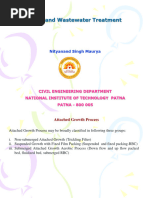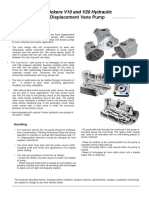Final Exam
Uploaded by
Arega GenetieFinal Exam
Uploaded by
Arega GenetieUniversity of Gondar
Institute of Technology
School of civil and hydraulics
Department of Hydraulic and Water Resource Engineering
Final Examination [50%] Time allotted = 3፡30 hr
Course Name: Sewage Treatment [CEng 4151] Academic Year: 2019/20,
Semi: I
Credit Hr: 3 [ECTs -5 CP] Target Group: 5th year Civil Extension
Part one: Short answer
1. Classify all types of Biological wastewater treatment system as attached and suspended
growth process? [2pts]
2. Explain the Role of Microorganisms in Wastewater Treatment? [2pts]
3. Explain what will happen in Activated sludge treatment plant when F/M is high and low?
[2pts]
4. What are the factors which affects sludge digestion process? [2pts]
Part two: Workout
1. Estimate the BOD removal efficiency (for each Trickling filter and overall) and effluent
BOD5 of a two stage trickling filter using the following given conditions. Also determine
Hydraulic loading rate and Organic loading rate for each filter. [10pts]
Wastewater temperature = 20oC
Plant flow (Q) = 7570 m3
BOD5 in raw waste = 300 mg/L
Volume of filter (each) = 453 m3
Depth of filter (each) = 2.13 m
Recirculation for filter 1 = 1.5 Q
Recirculation for filter 2 = 0.8 Q
35% of BOD of raw wastewater is removed by primary settling.
2. A certain college discharges 17,360 m3 /d of treated wastewater into a nearby river. The
treated wastewater has a BOD5 of 12 mg/L and kd of 0.12 d-1 at 20oC. The river has a flow
rate of 0.43 m3 /s and an ultimate BOD of 5.0 mg/L. The DO of the river is 6.5 mg/L and
the DO of the wastewater is 1.0 mg/L. Saturation dissolved oxygen can be read from
table, thus at 20oC, DOs = 11.33 mg/L. Use re-oxygenation constant of 0.24/d at 20 oc.
The average speed of the stream flow in the river is 0.03 m/s and the depth is 5.0 m.
Determine the DO concentration at a point 5 km downstream from the college discharge
into the river. Also determine the critical DO and the distance downstream at which it
occurs. Based on the above result sketch DO-sag curve. [16pts]
3. An average operating data for conventional activated sludge treatment plant is as
follows: Wastewater flow,
Q = 37000m3/d
Volume of aeration tank, V = 10700m3
Influent BOD, Yo = 280mg/l
Effluent BOD, YE = 30 mg/l
Mixed liquor suspended solids (MLSS), Xt = 2800mg/l
Effluent suspended solids,XE = 35mg/l
Waste sludge suspended solids, XR = 9900mg/l
Quantity of waste sludge, Qw = 250m3/d
Based on the information above data, determine:
(a) Aeration period (hrs) [1pt]
(b) Food to microorganism ratio (F/M) [2pts]
(c) Percentage efficiency of BOD removal [1pt]
(d) Sludge age (days) [2pts]
4. An activated-sludge system has an influent flow of 23,700 m3 /d with suspended solids of
86 mg/L. Three aeration tanks hold 1600 m3 each with MLSS of 2500 mg/L. Calculate
the sludge age for the system. [10pts]
GOOD LUCK
By: Arega G
You might also like
- DS439 - EN-Code of Parctise For Domestic Sanitary Installations100% (3)DS439 - EN-Code of Parctise For Domestic Sanitary Installations76 pages
- Recommended Rate of Charges of Practicing Master Plumber NampapNo ratings yetRecommended Rate of Charges of Practicing Master Plumber Nampap2 pages
- l20303 Truck Troubleshooting Guide Rev. 11 16 PDFNo ratings yetl20303 Truck Troubleshooting Guide Rev. 11 16 PDF2 pages
- Gradually Varied Flow and Rapidly Varied FlowNo ratings yetGradually Varied Flow and Rapidly Varied Flow3 pages
- Chapter Two - Analysis and Design of Flat SlabNo ratings yetChapter Two - Analysis and Design of Flat Slab56 pages
- Steel and Timber Structures: (CENG4123)No ratings yetSteel and Timber Structures: (CENG4123)34 pages
- Chap 3 - 1 Irrigation Distribution NetworkNo ratings yetChap 3 - 1 Irrigation Distribution Network48 pages
- RC I&II, SD &bridge Eng Model-Tutoarial ExamNo ratings yetRC I&II, SD &bridge Eng Model-Tutoarial Exam63 pages
- University of Gondar Institute of Technology Sewage Treatment and Disposal Assignment For 3 Year Cotm Max. of 5 Students Per Group100% (1)University of Gondar Institute of Technology Sewage Treatment and Disposal Assignment For 3 Year Cotm Max. of 5 Students Per Group2 pages
- Slab 1: Two - Way Slab (Case 2 - Four Edges Continuous)No ratings yetSlab 1: Two - Way Slab (Case 2 - Four Edges Continuous)58 pages
- Question Bank: Cem701 Design of Reinforced Concrete Structures Ii Unit 1No ratings yetQuestion Bank: Cem701 Design of Reinforced Concrete Structures Ii Unit 17 pages
- MSCE 509-106-Deep Beams Using Strut and Tie ModelsNo ratings yetMSCE 509-106-Deep Beams Using Strut and Tie Models26 pages
- Lec7 Flexibility Method and Stiffness MethodNo ratings yetLec7 Flexibility Method and Stiffness Method34 pages
- Mekelle Uninversity Ethiopian Instituite of Techonology - Mekelle School of Civil EngineringNo ratings yetMekelle Uninversity Ethiopian Instituite of Techonology - Mekelle School of Civil Enginering39 pages
- An Analitical Approach To Demand-Capacity Method: M B Sonawane, S K Dubey, DR S V DeodharNo ratings yetAn Analitical Approach To Demand-Capacity Method: M B Sonawane, S K Dubey, DR S V Deodhar7 pages
- Yield Line Theory Solved Examples Ii: Almustaqbal University College100% (1)Yield Line Theory Solved Examples Ii: Almustaqbal University College4 pages
- Department of Mechanical Engineering/ Hachalu Hundessa Campus Ambo University Meng2141No ratings yetDepartment of Mechanical Engineering/ Hachalu Hundessa Campus Ambo University Meng21416 pages
- Design Example of Flat slab by Equilavent frame methodNo ratings yetDesign Example of Flat slab by Equilavent frame method21 pages
- F G1153 Pages: 2: Answer Any Two Full Questions, Each Carries 15 MarksNo ratings yetF G1153 Pages: 2: Answer Any Two Full Questions, Each Carries 15 Marks2 pages
- Chapter 1 & 2 - Introduction & Route SelectionNo ratings yetChapter 1 & 2 - Introduction & Route Selection5 pages
- Ce 8 Sem Elective 3 Water Waste Water Treatment Summer 2018No ratings yetCe 8 Sem Elective 3 Water Waste Water Treatment Summer 20182 pages
- Elective-III - Water - Waste Water Treatment s18No ratings yetElective-III - Water - Waste Water Treatment s182 pages
- Introduction To Hydraulic & Water Resources Engineering DepartmentNo ratings yetIntroduction To Hydraulic & Water Resources Engineering Department40 pages
- Assesssment of Downriver Pollution Profile of Gondar City Wastewater and Its Influence On Keha RiverNo ratings yetAssesssment of Downriver Pollution Profile of Gondar City Wastewater and Its Influence On Keha River19 pages
- Water Demand & Source of Water and Well Hydraulics - DPP 01No ratings yetWater Demand & Source of Water and Well Hydraulics - DPP 016 pages
- WaterQualityStandardsAndRegulationsInSaudiArabia PME PDFNo ratings yetWaterQualityStandardsAndRegulationsInSaudiArabia PME PDF16 pages
- Design of Stormwater Management System: Ahmad Sana, PH.DNo ratings yetDesign of Stormwater Management System: Ahmad Sana, PH.D22 pages
- Brett Martin Underground, Rainwater, Soil, Waste Price List 2024No ratings yetBrett Martin Underground, Rainwater, Soil, Waste Price List 202476 pages
- Dimensions Specifications: 125 Booster Pump ControlNo ratings yetDimensions Specifications: 125 Booster Pump Control6 pages
- Counterflow Film Fill Application GuidelineNo ratings yetCounterflow Film Fill Application Guideline1 page
- Microlene Under Bench Purified Drinking Water System UB: ApplicationsNo ratings yetMicrolene Under Bench Purified Drinking Water System UB: Applications2 pages
- Chapter 3 - Water Resources - Class9 - MindmapNo ratings yetChapter 3 - Water Resources - Class9 - Mindmap2 pages































































































